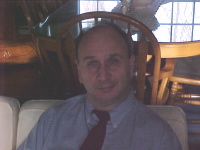Catholic or Puritan
By Ana Rodriguez-Soto
Catholic News Service
ORLANDO, Fla. (CNS) -- When speaking of firsts in U.S. history, the place should be Florida's St. Augustine, not Plymouth, Mass; the first settlers should be Spanish, not British; and the religion should be Catholicism, not Puritanism.
"It's about time that we corrected our brethren in the northern climes," Michael Gannon told an audience of Catholic journalists during a May 27 workshop at the Catholic Press Association's annual convention in Orlando. "By the time the pilgrims came to Plymouth, St. Augustine was up for urban renewal."
A professor emeritus at the University of Florida, Gannon has done extensive research on the history of the state and written the landmark book on the subject, "The Cross in the Sand," published in 1965.
He also wrote the first chapter of "Florida's Catholic Heritage Trail," a book to be published this year which encompasses the history of all seven of Florida's Catholic dioceses, beginning with the events in 1565 in St. Augustine.
Known as "the Grinch who stole Thanksgiving" by some New Englanders, Gannon said, "we have to tell the story" of Florida's early history and, by extension, the Catholic contribution to the history of the United States.
It was Juan Ponce de Leon in 1521 who first explored the territory he christened Florida, after the Spanish name for Easter, Pascua Florida. That was 86 years before the British arrived in Jamestown, Va., in 1607 and nearly a century before the pilgrims landed at Plymouth Rock in 1620.
"There is a place called St. Augustine. It's critically important to Florida history. It's critically important to Catholic history. It's critically important to our country's history," said Eric Johnson, director of the Mission Nombre de Dios (Name of God) in St. Augustine, the first Catholic parish in the United States.
Johnson and Susan Parker, of the Division of Historical Resources for Florida's Department of State, joined Gannon as co-presenters of the workshop.
According to Gannon and evidence uncovered by state archeologists, Ponce de Leon and subsequent Spanish explorers had landed in what are now Tampa Bay and Pensacola Bay, and explored as far north as the Chesapeake Bay, by 1526.
They brought with them not just soldiers but farmers, families and Spanish priests -- Dominicans, Franciscans, Jesuits -- who set up 38 mission outposts in Florida by 1655. In fact, the name San Francisco was given to a mission in Potano, near present-day Gainesville, about 170 years prior to the use of the name in California.
"These were selfless men of God who wrote one of the great stories in the history of the faith in North America," Gannon said. "Here were the first people who carried the lamp of Christianity into the darkened interior of North America."
Contrary to popular belief and what is taught in some history books, "the natives were not in any way used or abused by the friars, nor would they let them be abused by others," Gannon said.
He described the priests as living among the Indians as Peace Corps volunteers do today, teaching them European ways without imposing their beliefs. By 1655, the Franciscans counted 26,000 native converts in Florida.
Gannon called the Spanish priests "the first great defenders of human, civil and religious rights in what is now the United States." He stressed that "no Indian was ever converted by force."
Johnson noted that when Pedro Menendez de Aviles landed in 1565 in present-day St. Augustine, just south of Jacksonville, he claimed the land for Spain with both a flag and a cross. Seeing him and the rest of the Spaniards reverence the cross, the Timucuan Indians who had gathered at the site followed suit.
"The very beginning of the teaching of the Gospel in the United States was by example rather than by word," said Johnson.
That gesture was followed by the first Mass on U.S. soil. It was celebrated by the priest who accompanied the expedition, Father Francisco Lopez de Mendoza Grajales, on Sept. 8, 1565, on the site known to this day as Mission Nombre de Dios (Name of God).
After the Mass, Menendez de Aviles invited the Timucuans to join him for "the first communal meal of Europeans and natives together," Gannon said. "This was the first communal act of thanksgiving in the first permanent European settlement of what is now the United States."
Nombre de Dios also is the site of the first Marian shrine in the United States, the Shrine of Our Lady of La Leche y Buen Parto (The Milk and Happy Delivery), a devotion carried over from Spain by couples seeking to conceive or bear healthy children.
"People come from all over the United States and other countries to pray to Our Lady of La Leche," Johnson said. "What started with Father Lopez as the first parish priest has continued to this day."


0 Comments:
Post a Comment
<< Home